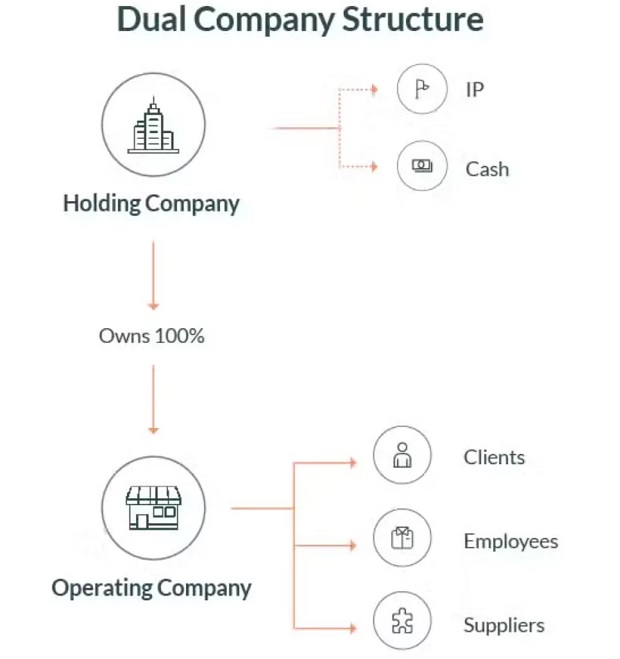- within Corporate/Commercial Law topic(s)
- within Corporate/Commercial Law, Tax and Real Estate and Construction topic(s)
- with Senior Company Executives, HR and Finance and Tax Executives
- in Turkey
- with readers working within the Chemicals, Law Firm and Construction & Engineering industries
A company structure is a great way of running your business as it offers a high level of legal protection. However, you may be at a stage where your business owns a large amount of intellectual property and other important assets, is beginning to seek investment opportunities, or expanding its operations into different business units. If this is the case, moving your business to a dual company structure may be appropriate. This article outlines the dual company structure, why it could make sense for your business, and how to transition from a single to dual company structure.
What is a Dual Company Structure?
A dual company structure involves:
- a holding company, where the shares are owned by the founders/investors; and
- one or more operating companies, where the shares are 100% owned by the holding company.
As the names suggest, the holding company's sole responsibility is to hold all of the business' important assets, such as:
- intellectual property;
- stock;
- machinery; and
- any cash from investment.
On the other hand, the operating company enters into contractual arrangements with customers, employees, suppliers and other parties.

For the most part, one operating company is sufficient to run your business. However, if you have separate business units or businesses, it is a good idea to incorporate a separate operating company for each business.
What are the Benefits of a Dual Company Structure?
Asset Protection
One of the key advantages of a dual company structure is asset protection. Since the holding company is the legal owner of key assets, those assets would be protected from legal claims, such as third-party claims made by suppliers or customers.
For example, Jacob Techman owns a software-as-a-service business and operates through a dual structure. His holding company, Jacob Tech Pty Ltd, owns all of the business' intellectual property. His operating company, Tech Techman Pty Ltd, enters into agreements with customers. A customer brings a claim for breach of contract against the business. Since that customer signed the agreement with the operating company, their only course of action is against that company. As Tech Techman Pty Ltd does not legally own any of the business' assets, it is highly unlikely they will be available to the customer if they win their case.
Investment Opportunities
Whilst not strictly necessary for taking on investors, a lot of sophisticated investors like to see that the business they are putting money into is run through a dual company structure, and much of this has to do with the above benefits of asset protection.
Steps to Change From a Single to Dual Company Structure
Restructuring from a single to a dual company structure can be lengthy and heavily hinges on tax advice. We recommend chatting with your accountant or tax advisor as a first step. Restructuring will usually attract capital gains tax consequences, but there may be 'CGT roll-over relief' available to you.
Broadly speaking, there are two ways of performing this restructure.
1. Restructuring Up
Restructuring up involves placing a new holding company above the existing company. This is a better option from an asset protection perspective, as the new holding company will be 'clean' (i.e. free from any historical claims).
Depending if you are relying on a particular form of CGT roll-over relief, the steps that are broadly involved are as follows:
- incorporate the new holding company, usually with the exact same shareholding as the existing company;
- transfer the shares in the existing company to the new holding company to ensure the existing company is now wholly owned by the holding company. This may need to be the subject of a share sale agreement;
- obtain any third-party consent to the change of control in the existing company. For example, you may need to review leases or key supplier contracts; and
- assign all intellectual property owned by the existing company to the new holding company. This would be subject to an IP licence and assignment agreement.
2. Restructuring Down
Restructuring down involves using your existing company as the holding company and incorporating a new operating company. Consequently, your existing company will wholly own the new one. Whilst this option is more straightforward to complete, it carries more risk. For example, the existing company could have existing claims or be exposed to potential claims (from an employee, supplier, client or government). As such, you would be exposing key assets that it holds (as a holding company) to risk. However, the risk may be low if the existing company is relatively new and has not begun trading.
Depending on tax advice, the steps involved in restructuring down are as follows:
- incorporate a new operating company that is wholly owned by the existing company;
- transfer certain business assets to the new operating company, like supplier contracts, employee contracts, leases, and other business assets (excluding IP). This would be subject to an asset sale agreement; and
- enter into an IP agreement between the holding company and operating company.
Key Takeaways
A dual company structure is a more sophisticated business structure that offers a higher level of protection and is more attractive to investors. Restructuring from a single to dual company structure is an involved process that hinges heavily on tax advice.
[View Source]
